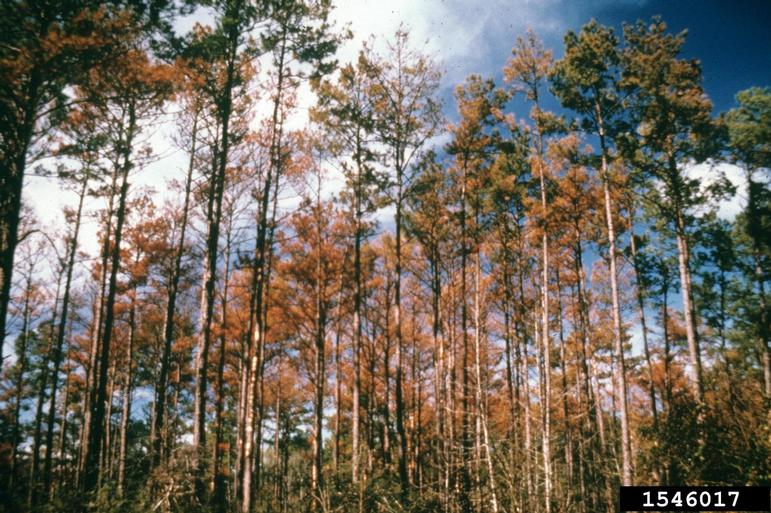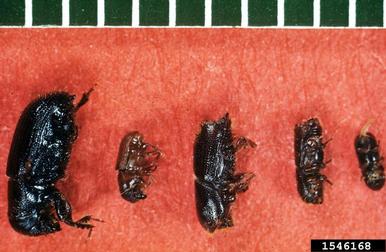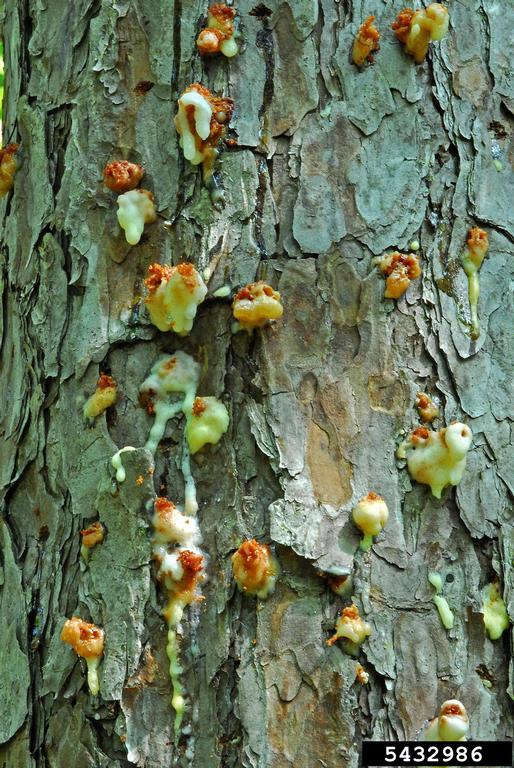
Pine trees dying from an infestation of Southern Pine Beetles. Credit: Ronald F. Billings, Texas A&M Forest Service, Bugwood.org
The Panhandle has been experiencing a prolonged drought the last few months, which can carry risks for increased bark beetle activity in pine forests. Bark beetles are common forest pests in the region, and the Southern Pine Beetle is particularly noted for large epidemic infestations, especially in dry years. It is not the only beetle in the region, but it is the primary species of concern and the one that has the largest impacts. Other species also cause damage and timber losses such as Ips Beetles and Black Turpentine Beetles. All of these bark beetles have a habit of attacking stressed trees. The recent drought period is a stress factor that can increase the activity and lead to localized “bug spots”, as infestations are often called during larger outbreaks. Receiving some rain and moving into the wetter and colder winter period will hopefully reduce bark beetle activity. In the meantime, it is a good idea to monitor your forest landholdings to be aware of any activity you may see. Just because you see some isolated bark beetle activity in your stand does not mean it is cause for significant alarm. Most spots resolve on their own as conditions improve, but it is something to monitor and get advice on, if you notice several trees impacted.

The Five Common Southern Bark Beetles. The largest is Black Turpentine Beetle, The Middle is Southern Pine Beetle, and the other three are Ips species. Photo Credit: Roger Anderson, Duke University. Bugwood.org
Monitoring is key to detecting potential bark beetle problems early. If infested and dying pines are noted, particularly if it is several trees or in higher risk timber stands, it may become an issue. It is important to realize that Southern Pine Beetles are the bark beetle in Florida that are most destructive and can become epidemic at certain times. Annually, the Florida Forest Service puts out a Southern Pine Beetle Forecast based on an extensive monitoring program using traps and aerial surveillance, which can be accessed from the 2025 Florida Southern Pine Beetle Forecast. For 2025, the prediction was a low probability of outbreaks for most areas of the state, but there were areas of the Panhandle with elevated risks. Wakulla County had the most significant risk, with slightly elevated risks in Leon, Gadsden, Liberty, and Okaloosa counties. Managers in these counties should be on the lookout, particularly with the recent drought conditions. Loblolly pine is the most susceptible species in our area, particularly in dense or crowded conditions. All pines are susceptible, but longleaf pine tends to be less susceptible than other species. Regardless of the pine species, southern pine beetle infestations are of particular concern compared to other bark beetle species.

Signs of Southern Pine Beetle feeding. Credit: Erich G. Vallery, USDA Forest Service – SRS-4552, Bugwood.org
Other bark beetles such as Ips and Black Turpentine Beetles usually attack stressed or dying trees and do not reach epidemic proportions like the Southern Pine Beetle. Events such as droughts and hurricanes typically cause an increase in these species’ activity levels through tree stress, but they are of less concern. Usually, several trees are impacted after the stress event in a small area over a brief time. Symptoms of bark beetle attack are similar for all species. Needle dieback throughout the crown, first yellowing and then going to reddish brown is usually what is noticed. Sap and resin weeping from the tree and forming dried lumps that can look like “popcorn” is another sign to look for, along with boring dust and frass around the tree base.
Bark Beetle spots begin to show more in the late summer and fall, which is often when the symptoms become more noticeable. It is important to realize that a small spot does not mean it will wipe out an entire area. In forest settings, the best remedy is cultural control – removing infested trees when a significant risk is posed and it is clear the spot may expand in the future. This requires careful consideration of the type, extent, and risk posed by the outbreak and the particular bark beetle species involved. For small, isolated spots that are only a few trees and a bark beetle species that is not Southern Pine Beetles, it may be best to let the spot die out naturally. If you notice an area of concern in your pine stand, it is best to consult with a professional forester and determine the best course of action. You can contact the Florida Forest Service County Forester for technical assistance. If you have a private consulting forester or land manager, reach out to them for assistance and recommendation on a course of action. Your local UF/IFAS Extension Office is also an excellent resource.
- Recent Drought Conditions Increase Pine Bark Beetle Risk - October 31, 2025
- Panhandle Landowner Assistance Expo – August 23 - July 11, 2025
- Tick Prevention – An Important Safety Measure When Working Outdoors - April 25, 2025
